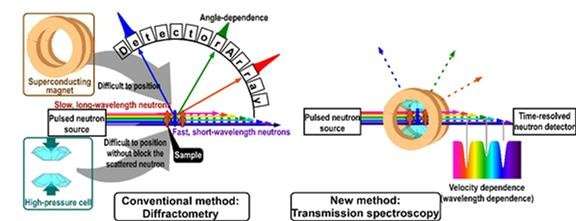World's first observation of spin arrangements using neutron transmission

For the first time in the world, NIMS, JAEA and J-PARC jointly succeeded in observing electron spin arrangements in sample materials by applying a neutron beam to a sample and quantifying the neutrons transmitted through it. Conventional methods measuring neutrons scattered by the spins at various angles are principally incompatible with sample environment equipment that blocks the scattered neutrons. The newly developed method measures the linear transmission of neutrons through a sample material from a neutron beam source, minimizing this difficulty. Thus, the new transmission spectroscopy is a promising tool for measurements of spin arrangements under various extreme conditions.
Extreme conditions such as ultra-high pressure, ultra-high magnetic field, and ultra-low temperatures are attractive frontiers in magnetism. Neutron diffractometry measuring neutrons scattered by the spins at various angles has been a unique tool for clarifying the spin arrangements directly. However, it is not easy to measure neutrons scattered at the sample under extreme conditions, because the generations of such extreme conditions are possible in smaller, narrower, or thinner sample space in the sample environment equipment; consequently, the equipment covers almost the whole aspects of the scattered neutrons.
When a neutron beam is applied to a sample material, the neutrons transmitted through the material attenuate in proportion to the extent to which they are scattered. The NIMS-led research team therefore hypothesized that spin arrangements in materials could be characterized by simply measuring the transmitted neutrons. The team applied neutron pulses produced at J-PARC to a nickel oxide sample with known spin arrangements and analyzed the relationship between the intensity and wavelength of neutrons transmitted through the material. The team found that the transmission intensity of neutrons of specific wavelengths―which were expected to respond to known spin arrangements―was very low. Incident neutron beams are always transmitted through a sample material in a linear fashion, hence, the new method requires only one small through-hole in sample environment equipment and greatly improve flexibility in equipment design.
This study demonstrated that neutron transmission measurements are an effective method of characterizing spin arrangements in materials under various extreme conditions. In future studies, we will leverage the working principle of this method to design multi-extreme condition-generating devices, facilitating the search for novel spin arrangements. In addition, application of the new method―linear transmission of incident beams through sample materials―to neutron radiography would enable non-destructive observation of spin state inside magnetic devices, which has been impossible to achieve by known techniques. This could facilitate the development of more advanced magnetic devices.
More information: Hiroaki Mamiya et al. Magnetic Bragg dip and Bragg edge in neutron transmission spectra of typical spin superstructures, Scientific Reports (2017). DOI: 10.1038/s41598-017-15850-3
Journal information: Scientific Reports
Provided by National Institute for Materials Science




















